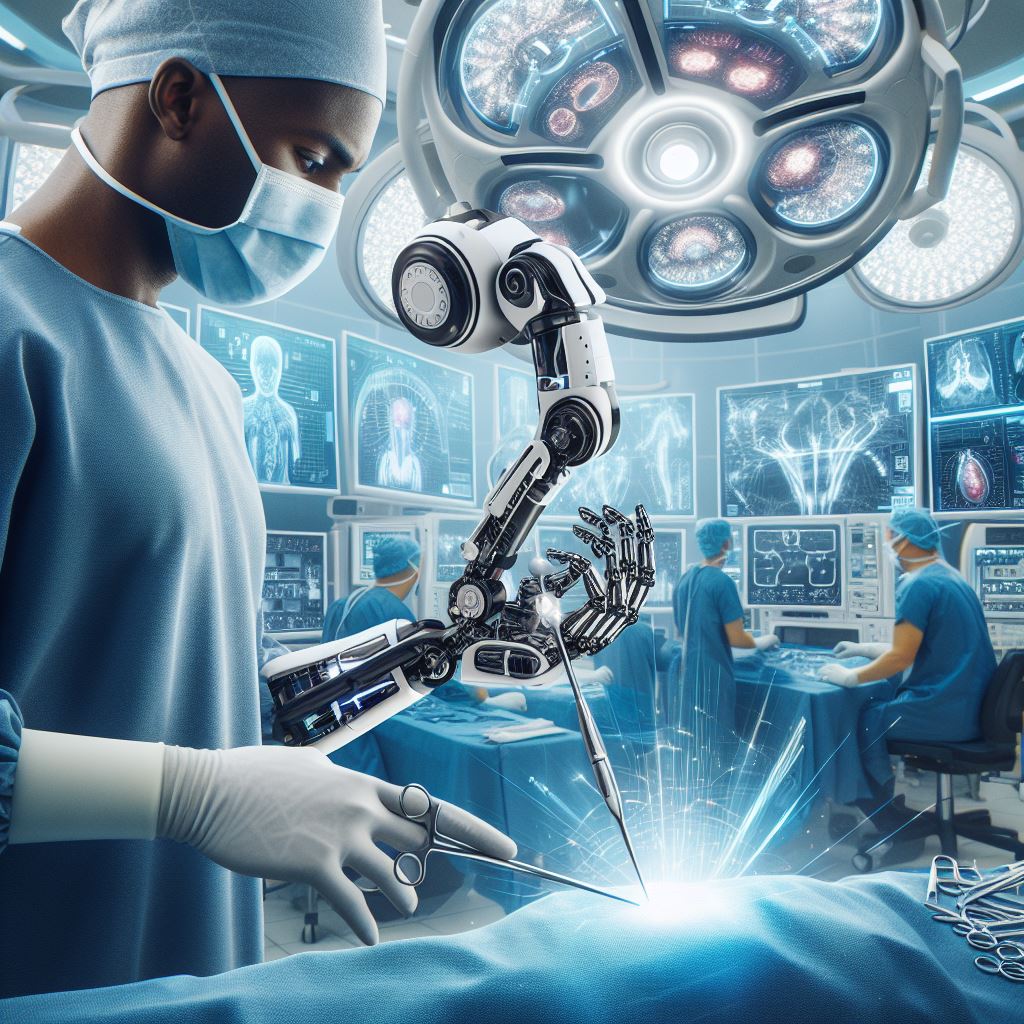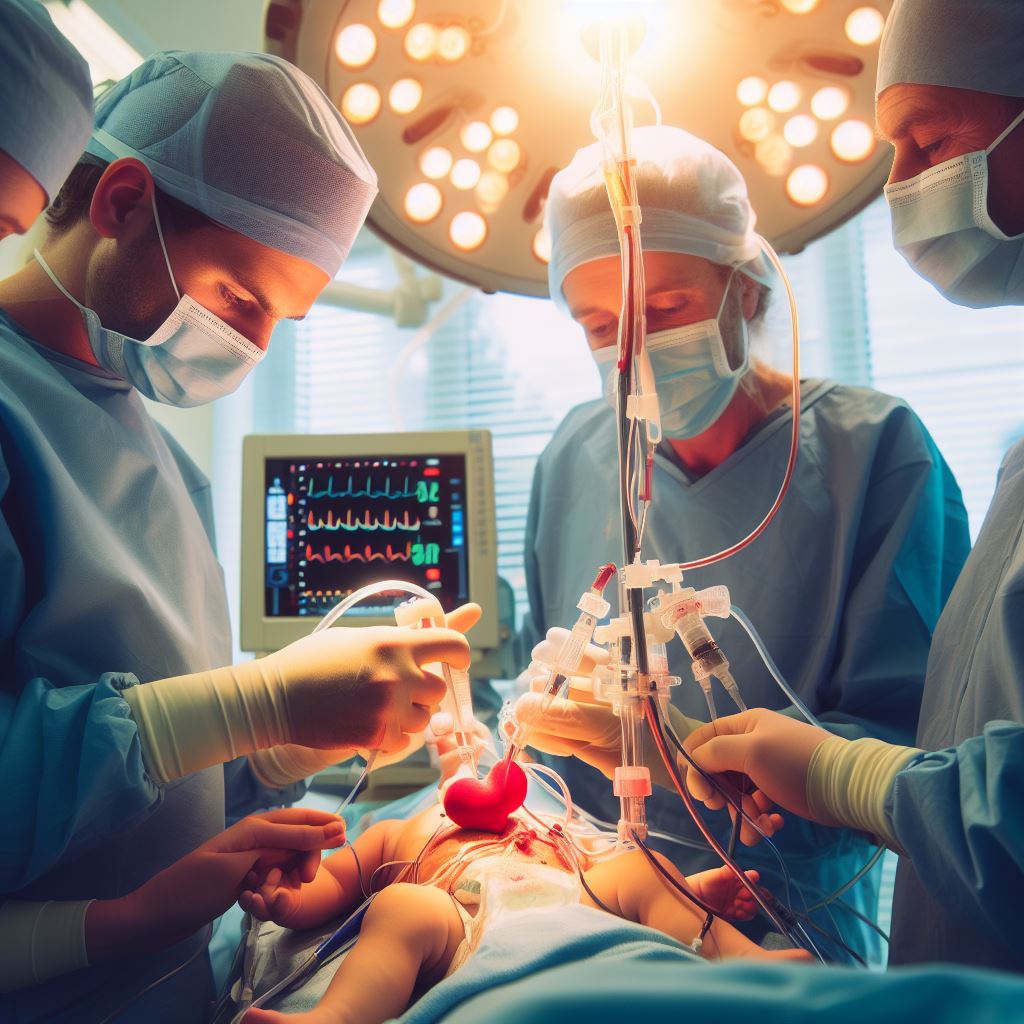Introduction
Robotics surgery is a revolutionary technique that uses robotic systems to perform surgical procedures with precision and accuracy.
Over the years, it has gained increasing popularity and use in Australia.
Robotic surgery has transformed the field of medicine by providing surgeons with advanced tools and capabilities.
With robotic systems, surgeons can perform complex surgeries with enhanced precision, minimal invasiveness, and improved patient outcomes.
In recent years, the adoption of robotic surgery in Australia has seen a significant rise.
It is being used in various specialties, including urology, gynecology, and colorectal surgery.
The increasing popularity of robotic surgery can be attributed to its numerous advantages.
One of the key benefits of robotic surgery is its minimally invasive nature.
It allows for smaller incisions, resulting in reduced pain, shorter hospital stays, and faster recovery times for patients.
Additionally, robotic surgery offers improved visualization and dexterity for surgeons.
The robotic arms provide a 3D view of the surgical site, enabling surgeons to navigate with precision and perform intricate tasks with ease.
Moreover, robotic surgery ensures greater precision, as the robotic arms filter trimmer hand movements, eliminating any tremors or shaking.
This level of precision enhances surgical outcomes and minimizes the risk of complications.
The future of robotic surgery in Australia looks promising, with continuous advancements in technology and increasing surgeon expertise.
As more surgeons undergo specialized training in robotic surgery, the availability and accessibility of such procedures are expected to grow.
In summary, robotic surgery has gained significant popularity in Australia due to its minimally invasive nature, improved visualization, and enhanced precision.
As it continues to evolve, the future of robotic surgery in Australia holds great promise in revolutionizing the field of medicine.
Benefits of robotic surgery
Robotic surgery has revolutionized the field of medicine, offering numerous benefits over traditional surgical techniques.
Improved Precision and Accuracy
- Robotic surgical systems provide surgeons with enhanced precision and accuracy, minimizing the risk of human error.
- The robotic arms can perform complex movements with a greater range of motion than a human hand.
- Surgeons can achieve more precise incisions and sutures, leading to better surgical outcomes.
Minimally Invasive Procedures
- Robotic surgery allows for smaller incisions, resulting in less trauma to the surrounding tissues and organs.
- With the use of specialized instruments, surgeons can access hard-to-reach areas of the body without the need for large incisions.
- Minimally invasive procedures reduce postoperative pain, scarring, and the risk of infection.
Reduced Risk of Complications
- Robotic surgery offers a higher level of surgical safety due to its advanced imaging capabilities.
- The systems provide surgeons with a magnified and high-definition view of the surgical site, allowing for better identification of structures.
- With real-time imaging, surgeons can avoid vital structures, minimizing the risk of accidental damage.
- Reduced complications result in shorter hospital stays and lower healthcare costs.
Faster Recovery Time for Patients
- Robotic surgery generally results in shorter recovery periods compared to traditional open surgery.
- Smaller incisions mean less damage to the surrounding tissues, leading to reduced pain and discomfort for patients.
- Patients can experience shorter hospital stays and quicker return to their daily activities.
In review, robotic surgery has brought significant advantages to the medical field in Australia.
The improved precision and accuracy offered by robotic systems have led to better surgical outcomes.
Minimally invasive procedures have reduced patient trauma and improved postoperative recovery.
The use of advanced imaging has resulted in a reduced risk of complications.
Ultimately, patients benefit from faster recovery times, shorter hospital stays, and improved overall quality of care.
With ongoing advancements in robotic technology, the future of robotic surgery in Australia looks promising and will continue to transform the way surgeries are performed.
Read: Salary Guide: Healthcare Admins in Australia
Current state of robotic surgery in Australia
The current state of robotic surgery in Australia is growing rapidly, with more hospitals and clinics adopting robotic surgery systems.
Availability and Adoption of Robotic Surgery Systems
- Many major hospitals in Australia have invested in robotic surgery systems, such as the da Vinci Surgical System.
- As of now, over 40 hospitals across the country have implemented robotic surgery systems.
- However, the availability of robotic surgery systems may vary from region to region.
- In metropolitan areas, there is generally wider access to robotic surgery systems compared to rural areas.
- Public hospitals have also started to incorporate robotic surgery systems into their healthcare services.
- Private clinics and specialist centers are increasingly adopting robotic surgery systems as well.
Types of Surgeries Performed with Robotic Systems
- Robotic surgery systems in Australia are primarily used for urological procedures, such as prostatectomy.
- Other types of surgeries that can be performed with robotic systems include gynecological and colorectal procedures.
- Robotic systems enable highly precise and minimally invasive surgeries, resulting in quicker recovery times for patients.
- Surgeons have also successfully used robotic systems for cardiac and thoracic surgeries.
- The versatility of robotic surgery systems allows for various complex procedures to be performed with improved outcomes.
Challenges and Limitations in Implementing Robotic Surgery
- Cost is one of the main challenges in implementing robotic surgery systems in Australian hospitals and clinics.
- The initial investment for acquiring and maintaining robotic systems can be substantial.
- Training surgeons and medical teams to effectively use the robotic systems is another significant challenge.
- Robotic surgery requires specialized skills and experience, which may limit the number of qualified surgeons.
- Moreover, patient access to robotic surgery systems may be limited due to long waiting lists in some healthcare facilities.
- There may be concerns about the safety and efficacy of robotic surgery among certain healthcare professionals and patients.
In a nutshell, the future of robotic surgery in Australia looks promising as more hospitals and clinics adopt robotic systems.
While availability varies, the number of healthcare facilities offering robotic surgery is increasing.
Urological procedures are the most common, but the range of surgeries performed with robotic systems is expanding.
Despite challenges related to costs, training, and patient access, the benefits of robot-assisted surgery, such as improved precision and faster recovery, make it an attractive option.
With further advancements and ongoing research, the field of robot-assisted surgery is likely to revolutionize healthcare in Australia.
Read: Healthcare Admin Roles: What You Need to Know
Advancements in Robotic Surgery Technology
In recent years, there has been significant progress in the field of robot-assisted surgery technology.
Innovations in this area have revolutionized the way surgeries are performed, offering numerous benefits to patients and healthcare professionals alike.
Let’s delve into some of the recent advancements that have taken place.
Recent Innovations in Robotic Surgery Systems
- Introduction of single-port robot-assisted surgery systems, allowing for smaller incisions and reduced scarring.
- The use of advanced imaging technology such as 3D visualization, enhancing precision and accuracy.
- Improved ergonomics in robotic consoles, providing surgeons with superior control and comfort during procedures.
- Integration of haptic feedback systems enabling surgeons to feel tactile sensations while operating robotic instruments.
These innovations have contributed to safer and more efficient surgeries, resulting in better patient outcomes and faster recovery times.
Development of More Sophisticated Robotic Arms and Instruments
- Increased dexterity of robotic arms, mimicking the natural movements of a surgeon’s hand with greater precision.
- Enhanced instrument articulation, enabling surgeons to access hard-to-reach areas within the body.
- Integration of laser technology into robotic instruments, allowing for more precise cutting and cauterization.
- The advent of miniaturized robotic instruments, reducing the invasiveness of procedures and minimizing trauma to patients.
These advancements have not only expanded the range of surgeries that can be performed robotically but have also improved surgical precision and minimized the risk of complications.
Integration of Artificial Intelligence and Machine Learning
- Utilization of artificial intelligence algorithms to analyze preoperative and intraoperative data, aiding in surgical planning and decision-making.
- Implementation of machine learning algorithms to improve the accuracy of robot-assisted procedures over time.
- Integration of computer vision technology, allowing robots to perceive and interpret visual feedback during surgeries.
- Real-time data processing capabilities enabling robots to adapt and respond to dynamic changes during a procedure.
This integration of artificial intelligence and machine learning offers tremendous potential in enhancing the capabilities of robot-assisted surgery systems.
It enables surgeons to achieve even greater precision, efficiency, and safety in their procedures.
In general, advancements in robot-assisted surgery technology have transformed the landscape of healthcare in Australia.
These innovations, encompassing improved robotic systems, sophisticated instruments, and the integration of artificial intelligence, have empowered surgeons and improved patient outcomes.
As technology continues to evolve, we can only anticipate further enhancements in robot-assisted surgery, leading to even better healthcare for all.
Read: A Day in the Life of a Healthcare Admin in Australia

Learn More: Adelaide’s Advances in Pediatric Surgery
The impact of robotic surgery on healthcare professionals
Robotic surgery has made a significant impact on healthcare professionals in Australia, completely transforming the roles and responsibilities of surgeons and surgical teams.
This development in medical technology has not only revolutionized surgical procedures but also introduced a need for specialized training and expertise.
Changing Roles and Responsibilities
With the introduction of robot-assisted surgery, surgeons are now able to perform complex procedures with greater precision and control.
The robot acts as an extension of the surgeon’s hands, allowing for minimally invasive surgery and increased dexterity.
As a result, surgeons need to adapt to using robotic systems and learn how to operate them effectively.
Additionally, the surgical teams are experiencing a shift in responsibilities.
Nurses and surgical assistants play a crucial role in robotic surgeries as they are responsible for setting up and monitoring the robotic equipment.
Their role now extends beyond traditional sterilization and instrument handling to include troubleshooting and maintaining the robotic system during procedures.
Your Personalized Career Strategy
Unlock your potential with tailored career consulting. Get clear, actionable steps designed for your success. Start now!
Get StartedSpecialized Training and Expertise
Robot-assisted surgery requires healthcare professionals to undergo specialized training to ensure they have the necessary skills and competence.
Surgeons need to familiarize themselves with the robotic system’s interface and learn how to control the robotic arms precisely.
Nurses and surgical assistants also receive intensive training on robotic system setup, troubleshooting, and maintenance.
They learn to navigate the robotic console and assist the surgeon effectively during procedures.
This specialized training ensures that healthcare professionals can maximize the benefits of robot-assisted surgery while minimizing the risks.
Potential for Job Creation
The rise of robotic surgery has created new opportunities for job creation in the field of surgical robotics.
With an increasing demand for robotic surgeries, healthcare facilities need a trained workforce to operate and maintain these systems.
Specialized training programs and courses have been developed to meet this need.
These programs offer comprehensive training in robot-assisted surgery techniques and technologies.
They equip healthcare professionals with the expertise to excel in this emerging field, creating job opportunities as robotic surgical teams continue to expand.
Job creation is not limited to surgeons and nurses alone.
The field of robotic surgery necessitates professionals with expertise in biomedical engineering, robotics, and software development.
These individuals work alongside healthcare professionals to design and improve robotic systems, further fueling job creation and innovation.
In fact, robotic surgery has significantly impacted healthcare professionals in Australia.
Surgeons and surgical teams have witnessed a changing landscape in their roles and responsibilities, with a greater reliance on robotic systems.
Specialized training and expertise have become essential for healthcare professionals to adapt to these changes.
Furthermore, the potential for job creation in the field of robot-assisted surgery offers exciting opportunities for professionals with diverse backgrounds and skillsets.
Read: The Future of Healthcare Administration in Aus
Future potential of robotic surgery in Australia
The future of robot-assisted surgery in Australia holds immense potential for further growth and advancement.
With rapidly evolving technology and increasing demand for minimally invasive procedures, robot-assisted surgery is poised to revolutionize the healthcare industry in the country.
Opportunities for Further Growth and Advancement
- Collaboration between medical professionals, engineers, and manufacturers can drive advancements in robotic surgery.
- Increasing funding and investment in research and development can facilitate the expansion of robotic surgery capabilities.
- Development of training programs and educational initiatives can ensure a skilled workforce to operate robotic systems.
Potential Areas of Expansion for Robotic Surgery Applications
- Gynecological surgeries, such as hysterectomies and ovarian procedures, can benefit from robotic assistance.
- Urological procedures, including prostatectomies and kidney surgeries, can be enhanced through robotic technology.
- Cardiovascular surgeries, such as coronary artery bypass grafting, can leverage robotics for improved precision.
Potential Benefits to Patients and the Healthcare System
- Reduced invasiveness of robotic surgery leads to shorter hospital stays and faster recovery times for patients.
- Precise movements and enhanced visualization offered by robotic systems can minimize surgical errors and complications.
- Improved patient outcomes and reduced post-operative pain contribute to overall patient satisfaction and quality of life.
- Robotic surgery can alleviate the strain on healthcare resources by enabling more efficient procedures and quicker patient turnover.
- The use of robotic systems in surgery can attract and retain highly skilled healthcare professionals.
With the potential for growth and expansion in various surgical specialties, robot-assisted surgery in Australia holds the promise of transforming the healthcare landscape.
The country’s progressive regulatory environment and high standards of healthcare make it an ideal location for the continued advancement of robotic surgical techniques.
However, it is essential to address certain challenges and considerations to maximize the benefits of robotic surgery.
These include:
- Cost-effectiveness of robotic systems and procedures to ensure accessibility for patients without compromising quality of care.
- Safety measures and protocols to mitigate potential risks associated with robot-assisted surgery.
- Continued research and development to refine robotic technologies and expand their application to a broader range of surgeries.
- Ethical considerations regarding the role of robots and human interaction in the healthcare setting.
In essence, the future of robot-assisted surgery in Australia is incredibly promising.
By capitalizing on opportunities for growth, expanding applications, and reaping the benefits of improved patient outcomes, the healthcare system can embrace the transformative potential of robot-assisted surgery.
Conclusion
Robot-assisted surgery offers numerous advantages and potential in Australia.
The technology allows for more precise and minimally invasive procedures, resulting in shorter recovery times and reduced risks for patients.
Additionally, robot-assisted surgery can provide access to specialized procedures for patients in remote areas.
Looking ahead, the future of robot-assisted surgery in Australia holds great promise.
Advancements in technology will continue to enhance the capabilities of robotic systems, allowing for even more complex and intricate surgeries to be performed.
The integration of artificial intelligence and machine learning will further improve surgical outcomes and efficiency.
Despite the challenges and limitations, such as cost and training, the outlook for robot-assisted surgery in Australia remains positive.
The continued investment in research and development, along with the growing expertise of surgeons in this field, will pave the way for advancements and expanded applications.
The potential to revolutionize healthcare and improve patient outcomes is immense.
In closing, robotic surgery in Australia is poised for a bright future.
It will continue to redefine the landscape of surgical procedures, offering patients better outcomes, shorter recovery times, and greater accessibility to specialized treatments.
With ongoing advancements and support, the potential for robotic surgery to transform healthcare in Australia is tremendous.




